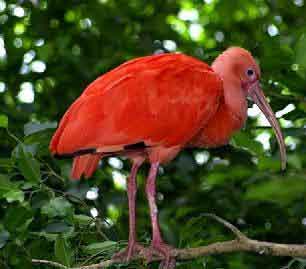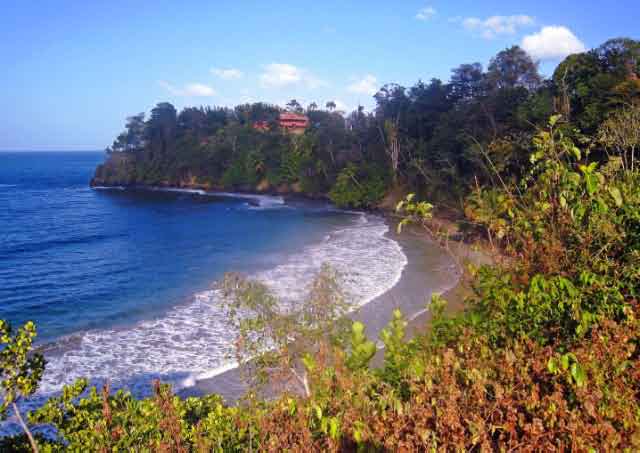|
Trinidad and Tobago Sailing Association
The anchorage in front of the Sailing Association was dotted with rows of mooring balls which left limited space to anchor. After several attempts in the poor holding we managed to secure the anchor in the far corner of the Bay. We were so tuckered out from the trip we just slept all day.
We were anchored just in front of the Coast Guard Station, sharing our spot with the resident Pelicans. |
 |
|
The flocks of Pelicans surrounding us indicated good culinary delights for them. We were entertained nightly as they dive bomb for fish showing off their acrobatic skills.
It is comical when they use their feet to stop themselves in midair before crashing into the sea. Hundreds of these brown pelicans bamboozle the skies around Ascension before clustering in a flotilla for the night to digest their full bellies.
|
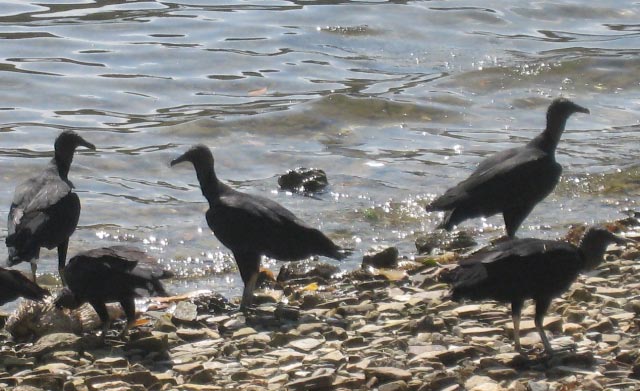
|
|
High above, the vultures circle. These huge scavengers are a common site all over Trinidad, seen picking on dead fish washed ashore or garbage strewn by the roadside.
Feb
5, 2010
We
headed into the Sailing Association to pay our fees
of $100/month to use the facilities. We knew we
wouldn't make use of the swimming pool or the
washrooms but the secure dinghy dock is worth the
price as theft is a major concern. |
February 6
Bussing it to the Mall
After listening to the morning Cruiser's net to get information on the day's happenings, we headed to the dinghy dock with Djarrka.
Sarah wanted to get a sim card for her broadband connector. This dongle is the greatest invention, allowing an internet connection anywhere there is a cell signal. With each new country, she just changes the SIM card and uses a pay as you go plan. She purchased her usb connector in Italy and unfortunately I have been unable to find a similar connector here. Anyway, we decided to tag along to a big Mall near Port of Spain.
We hopped a local maxi-taxi, a van which you flag down, like a bus, gathering people along the way and charging set rates dependant on where you are going. As the music blared to the beat of the bass vibrating at our feet, we drove along the busy road skirting the shoreline and revealing shops and buildings offering anything one might need in the modern world.
The Mall was like any other mall in Canada, with name brand stores. But the clothing shops were teaming with vividly bright colors and outlandish flamboyant styles, definitely geared for the younger set. I have not seen such colourful apparel for years, although much of our cruising has been to Muslim countries so that may explain it. The shops all seemed to be catering to the Carnival goers, with fancy costumes and dressy glitzy outfits.
We enjoyed meeting the Trinidaddys (and Trinimummys), very friendly melange of African, East Indian (almost 80%), some Asian, Caucasian, and you name it. English is the spoken language but with a delightful lilt and syllabic inflection. Many of the Trinis are very beautiful, especially the young girls. They certainly seem to have a great love of music, and it is not uncommon to see women and men singing along to the tunes on the taxis and buses, in the stores, or just walking down the street. Everywhere a "Hello" from us would immediately instigate a friendly response and conversation.
We ended up spending several hours wandering around the Mall which was kept at an icy air conditioned temperature. We took the bus back to the Sailing Assoc. in time to get ready for our first outing of the
Trinidad Carnival.
During Carnival, we were told that it is impossible to get a taxi or bus out of Port of Spain (where most of the events take place) back to our anchorage, about 15 km away because it is so busy. So we joined a group of other yachties in "Jesse Jame's" van. Jesse organizes tours and taxis around the island and for Carnival events. The pricetag was very high but we were guaranteed of getting a return ride back. Port of Spain is not the place that you would want to wander around late at night. Mostly as a result of the drug trade, there had already been 75 murders in the first month and a half of the year. Last year's death toll from murder was nearly 500! And the whole island only has a population of 1.4 million.
|
February 18
We sadly said goodbye to Norm as he flew back to Canada. We enjoyed spending time with him and sharing the Carnival Fun while he was here. We spent the next while chilling on the boat. The anchorage at TTSA is very well protected as we had situated ourselves at the back corner right in front of the coastguard station. Every afternoon the wind and waves savage the anchorage and the boats hobby horse like crazy, especially the ones tied on the moorings, but the island provides a break for us and we always remain relatively motionless.
Since our watermaker is acting up again, we filled our plastic water bottles at the dock for drinking. I was looking forward to a shower that was part of the $100 monthly fee for use of the facilities, but discovered there is only a cold water tap. The water in this anchorage is not fit for swimming, brown from the Orinoco River that feeds it.
It is probably the reason that there is such a high nutrient content in the water which has plagued us with growth on the bottom of Ascension. A colony of barnacles stubbornly multiply in numbers faster than we can scrape them off. When the coastguard requested that we move our boat out of the path on an incoming ship, 1200 RPM could not even get the boat to propel forward because of the aquaculture replacing our bottom paint!
|
|
Feb. 19,
Asa Wright Nature Centre
Trinidad has one of the highest avian species diversity in the world and so we took a tour to see some of the birds that live on the island.
Located in the foothills of the Trinidad rain forest, the Asa Wright Nature Centre is listed as "one of the 100 places you must visit before you die." The 1500 Acre Centre, originally a coffee and cocoa plantation, is well known for its high diversity of birdlife.
When we arrived we waited on the balcony for our guide, keeping entertained by hundreds of multicolored birds gathered around the numerous feeders. Some of the birds were so brilliant with their turquoise or incandescent plumage. An abundance of hummingbirds were suspended in the air around the feeders.
 Scurrying from piece of fruit to nut was a little Agouti, looking all the world like a much large version of a hamster. And huge lizards slithered across the paths. Scurrying from piece of fruit to nut was a little Agouti, looking all the world like a much large version of a hamster. And huge lizards slithered across the paths.
Our guide led us through the rainforest, pointing out floral and fauna trivia as we walked along. Through jungles of bamboo and twisty snarly trees, he pointed out various flowers, birds and a huge hornets nest. |
 |
 | |
 |
|

|
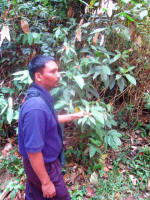 |
 He seemed particularly knowledgeable about the Leaf Cutter Ants, which are actually a fascinating little creature. Well worn trails can be seen everywhere through the brush where they have marked their route, carrying pieces of leaves back to their giant nest. They don't actually eat the leaves but use them to produce a mould that becomes their food source. The queen ant is about
the size of a mouse and lays millions of eggs at a time, killing the unlucky mates immediately after. The worker ants all all female and have razor sharp pinchers which our guide used to demonstrate the ease that the leaves and stems are cut. Soldier ants guard the entrance to the nests. He seemed particularly knowledgeable about the Leaf Cutter Ants, which are actually a fascinating little creature. Well worn trails can be seen everywhere through the brush where they have marked their route, carrying pieces of leaves back to their giant nest. They don't actually eat the leaves but use them to produce a mould that becomes their food source. The queen ant is about
the size of a mouse and lays millions of eggs at a time, killing the unlucky mates immediately after. The worker ants all all female and have razor sharp pinchers which our guide used to demonstrate the ease that the leaves and stems are cut. Soldier ants guard the entrance to the nests.
| |
The twisty drive through the dense jungle revealed various flowers, indigenous fruits and vegetable and trees that had been brought to the island, all of which Jesse pointed out to us.
Trinidad is truly a beautiful island, even in the dry season, green and lush and colorful with flowers. |
|
Caroni Swamp and Bird Sanctuary
At the Caroni Swamp and Bird Sanctuary, we boarded a boat and slid through the narrow channels and open lagoons of a protected swamp. Along the way we saw heron and other birds camouflaged in the trees. Our real mission was to view the bright Scarlet Ibis winging their way, by the thousands, to roost on an island. |
 |
 |
|
We tied the boat in the mangroves and patiently waited as dusk descended on the swamp. Soon a flock soared from the forest, filling the sky with brilliant red birds as they
gathered. They perched like vermillion jewels against the darkening green of the mangrove swamp, 3000 in number by the time we finally headed back to the van.
The trip back to the anchorage was slow going due to a back up of traffic so Jesse stopped to buy us all homemade ice cream
|
|
Speedboat Races
February 28
Together with Sarah and GB, we took a minivan to the Yacht Club down the highway to watch the speed boat races. These races are taken quite seriously in Trinidad and some very expensive and impressive machines turn up for the event. |
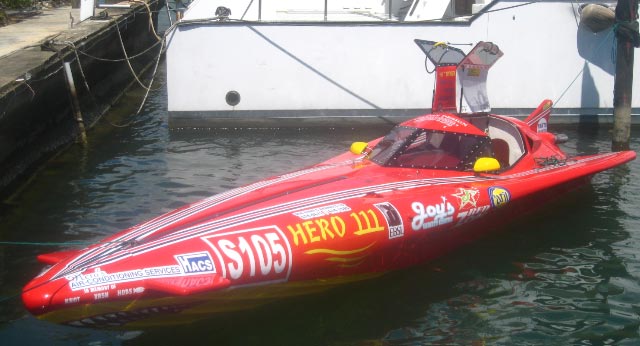 |
 |
|
 |
The sleek boats really ripped through the water, leaving in their wake a tremendous roar and spray that obliterated the horizon with a wall of water.
Finally when we could no longer endure the loud noise, we headed back to the marina.
|
 |
Cruiser's Pot Luck
Over the next couple of weeks, we caught up on boat chores and watched the weather. Each Monday evening, about 20 fellow cruisers shared a dish and barbequed some meat on the grill. A fun evening getting to know people on other boats in the anchorage. There has been much talk of the dangers of the crossing to Grenada due to pirate attacks.
|
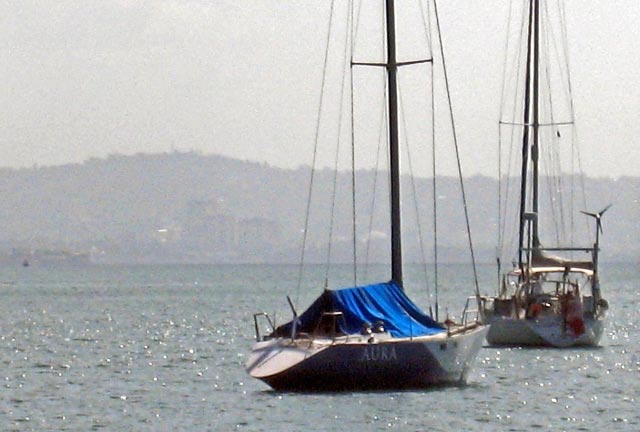 |
|
March 20
Pirates our Concern
Two more pirate attacks reported. Both happened to yachts eastbound to Trinidad, about 15 miles offshore. Both involved the firing of shots from rifles and handguns from a Pirogue into the cockpits of 2 individual boats, separate incidents. One of the boats succumbed to the threats and allowed the pirates to board. The pirates trashed the boat and stole everything they could carry off; electronics, clothing, freezer, personal items included!
The captain from the other yacht remained at the helm despite bullets flying past his ears and managed to fire off several shots from his flare gun in the direction of the invading vessel. The pirates then fled away.
Last night a yacht reported being followed at night by a Pirogue for several hours well west of the "normal" area of pirate activity. They were able to contact the Poinsetta Oil Rig and gain permission to pass close by. When near the rig, the chase boat veered off and fled east.
 So...here we are waiting for a weather window to travel on "the Pirate Path!" to Granada. It is not comforting to do the passage alone and even less desirable to plan a trip back to Trinidad for the hurricane season. So plans are definitely up in the air. Not many options for a safe haven away from the hurricane belt as this season, being unusually hot early, is thought to be at higher risk for severe tropical storms. So...here we are waiting for a weather window to travel on "the Pirate Path!" to Granada. It is not comforting to do the passage alone and even less desirable to plan a trip back to Trinidad for the hurricane season. So plans are definitely up in the air. Not many options for a safe haven away from the hurricane belt as this season, being unusually hot early, is thought to be at higher risk for severe tropical storms.
When Rusty and Archie (Agodonter) invited us to join them on an expedition to town we jumped at the chance to get off the boat. The wind had been blowing strong for several days, making the anchorage lumpy, the boat hobby horsing and jerking on the anchor chain.
In Port of Spain we returned to our favourite DVD joint where a little hole in the wall shop sold just released DVD's (many currently showing in the theatres) for under $1 each. We stocked up, then had a bite to eat before taking a drive into the hills of northern Trinidad.
|
|
 |
Adventures Along the North Coast
Rusty and Archie have been coming to Trinidad for many years and were frequent visitors to villages high in the hills. They knew just where to drive and took us on narrow twisty roads, so steep that we were sure the little car would not make it up the hills. |
|
 |
|
Honking before every blind corner in the road, it was always a challenge when meeting another car head on as someone surely had to give way and back up. The roads climbed and climbed, passing bright colorful houses, fuchsia, orange, purple, florescent pink, and every combination therein!
|
 |
 | |
We parked on a ridge that sported breathtaking
views of the Atlantic on one side and the Caribbean on the other with Tobago in the distance. |
|
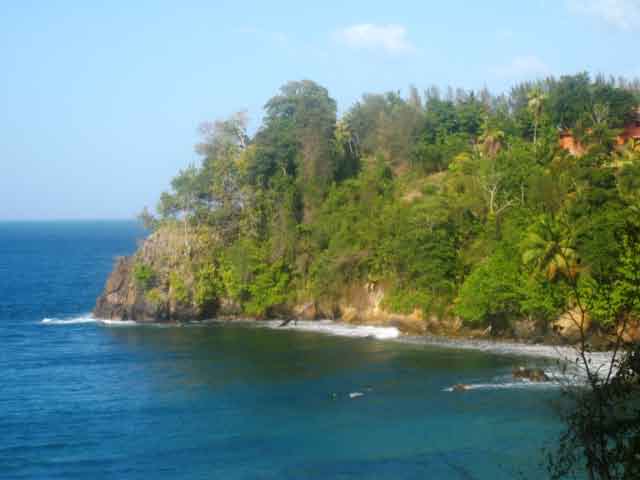 |
Squatters lived in tin shacks along the ridge and not only had the stunning view but a wonderful cool breeze blowing across the hills covered in banana, citrus, flowing trees and gardens of tomatoes, cabbage and sives (local name for green onions).
|
 |
|
The coastal drive, through valleys, across a suspension bridge and over hills, delighted us with magnificent views of Trinidad's finest beaches. There were signs of development and some housing projects in the area so it won't be long before this unspoilt unknown pearl of the island is discovered by foreigners looking for summer retreats.
From our high up vantage point we could see over the valleys to Maracus and Port of Spain, the smoky haze from dozens of forest fires burning out of control in the kindle dry landscape. It was the dry season (March) and the island was experiencing a severe shortage of water, the worst in 60 years. It had not rained for months and it is only the very beginning of the dry season.
The roads had major drainage ditches bordering their sides to catch the run-off water in the rainy season but it is forbidden for the locals to use this water. Or any other water that is not directly collected from their roofs. Including springs or streams! All water is owned by the Government. The government delivers water once a week and charges all the people whether they use it or not. Being such a dry season, the villagers complained that they had not had water delivered in over a week so their cisterns were dry. Watering their gardens was not allowed so many were not able to take their produce to market or even grow enough to feed their families. Many would sneak down to the spring at night for a bath.
|
|
Bake 'n Shark
We stopped at the famous Maracus beach for the national treat "Bake 'n Shark," which is a fish sandwich with all the dressings you could hope for. The entire beach is full of Bake 'n Shark stands and is THE place to go for the best snack on the island!
|
|
We drove through several remote and isolated villages, mostly inhabited by Rastas. We were amazed at all the locals that Rusty and Archie knew. We stopped to chitchat with many of their friends here and there as they hung out on the village streets or roadways. We found that if we greeted folks along the way, they would enthusiastically return a greeting and often stop to chat. A man, hard at work in his field took time to set down his scythe that he was using to clear the dense overgrowth away from a patch of land so he could plant cabbage, just to exchange some friendly words. We spoke with groups of men liming in the afternoon sun and even a friendly girl with a car full of kids stopped just to say hello. It was a wonderful experience just making those connections with the villagers and experiencing their genuine warmth and welcoming friendliness.
Another very steep ascend up the road brought us to the home of a family that Rusty and Archie had known for many years. We were all invited into their meager home, a small wooden structure, built haphazard with cloth curtains for doorways, water stained ceiling surround the bare light bulb which was the only source of light in a closet sized room that contained two facing couches, about 18 inches of clearance between them. A TV was the focal point, on which were ornaments of statues of Christ and other religious paraphernalia. On the cracked and peeling wall, magazine cut-outs were tacked depicting Jesus.
We were introduced to a warm and friendly woman, her married daughter, Vanessa, and
mother of her 1 month old baby girl. Rusty took photos of the baby to send to the women who otherwise would not have photos of the baby. We talked about their lives and families until Vanessa's husband Shaun came home. Vanessa had 2 other children (18 and 13 years) that were raised solely by her mother. As a twist of fate, she ended up looking after someone else's son from age 3 months to 3 years while the son's mother left the country to work. When the mother returned, Vanessa could not give the child up. After a lengthily battle the police were brought into the scene and Vanessa lost the boy. She was so unhappy that she and her husband decided to have a baby. Now Vanessa dotes on her daughter and will not even put her down ever. Her other 2 children still live with Gramma.
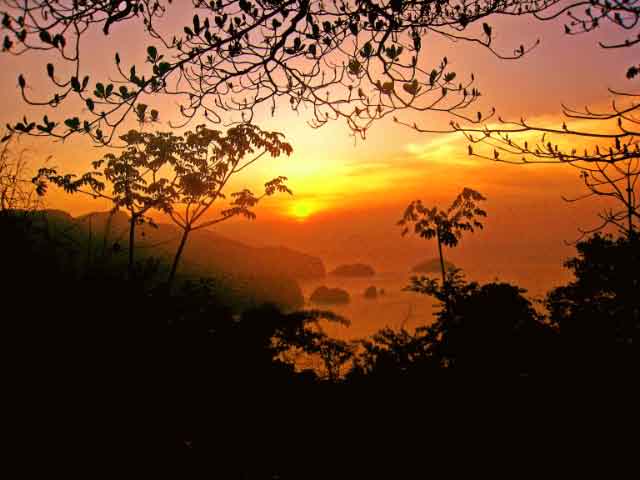 It was dark by the time we left for our drive down the hills and back to the anchorage. It was sad farewells to Rusty and Archie who were leaving for Colorado for Archie's knee surgery. Such is our traveling cruising life, the worst part is making good friend and then having to always say good-bye. It was dark by the time we left for our drive down the hills and back to the anchorage. It was sad farewells to Rusty and Archie who were leaving for Colorado for Archie's knee surgery. Such is our traveling cruising life, the worst part is making good friend and then having to always say good-bye.
Oil Spill
Apparently not an uncommon occurrence for Chagaramus Bay, oil dumped from a Thai tanker was responsible for many boats in the anchorage and marinas at Chagaramus to be covered with thick gooey oil, hard to clean off. The Oil Spill was an environmental tragedy to be certain. The oil continued to float around in the bay for several days but did not migrate around to the anchorage at TTSA so we did not suffer any ill effects. |
|
|
Convoy to Bequai
Our new dodger was still not finished, having been held up because Customs was on strike. We were anxious to move on but reluctant to make plans with the "Pirate reports" threatening a lonesome passage. We jumped at the chance to join a group of 7 local Trini Yacht Club sailors who had connections for a coast guard escort to the oil platform en route to the Bequia Regatta. It meant waiting a few extra days, but that option seemed to be the prudent one.
March 27
We checked out of Trinidad
and left with the convoy at 3 am.
 PHOTOS OF
TRINIDAD PHOTOS OF
TRINIDAD |
|

 Feb 4, 2010
Feb 4, 2010














